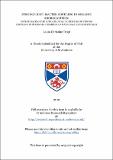Files in this item
Strong light-matter coupling in organic microcavities : investigating the fundamental principles of strong coupling in strongly disordered materials experimentally
Item metadata
| dc.contributor.advisor | Gather, M. C. (Malte Christian) | |
| dc.contributor.author | Tropf, Laura Christine | |
| dc.coverage.spatial | viii, 176 p. | en_US |
| dc.date.accessioned | 2019-06-14T10:19:48Z | |
| dc.date.available | 2019-06-14T10:19:48Z | |
| dc.date.issued | 2019-06-24 | |
| dc.identifier.uri | https://hdl.handle.net/10023/17893 | |
| dc.description.abstract | Strong light–matter coupling gives rise to intriguing possibilities like Bose-Einstein condensation at room temperature. In this context, organic semiconductors are particularly attractive because they combine large oscillator strengths with high exciton binding energies and thus readily enable large light–matter coupling strengths up to room temperature. Yet, in these commonly strongly disordered materials, the applicability of fundamental predictions developed for systems of high order needs to be verified. Hence, the validity of the theoretically predicted form of the coupling strength and of the coupled oscillator model is tested for strongly coupled organic microcavities in this thesis. Experimental investigations of metal-clad microcavities confirm the coupling strength to be proportional to the electric field with which the excitons interact and to the square root both of the oscillator strength of the material and of the number of chromophores inside the microcavity. Systematically varying these parameters demonstrates a non-zero threshold for the onset of the strong coupling regime for the first time, which confirms the applicability of the coupled oscillator model also for strongly disordered systems. Moreover, the effect of the coupling strength on the photoluminescence from organic microcavities is investigated. For metal-clad cavities, but not for microcavities with dielectric mirrors, an increase of the luminescence intensity with increasing coupling strength was found. For the latter system, a systematic study aimed to determine the properties of the cavity and of the organic material which are crucial for polariton lasing. However, experiments did not yield polariton lasing, for which two potential reasons are identified: (1) the vanishing of modes close to resonance and (2) pronounced bimolecular quenching in the studied material. Since organic microcavities are complex, systematic studies as presented in this thesis are an important step towards a more profound understanding of organic polaritons. | en_US |
| dc.description.sponsorship | "This work was supported by the Engineering and Physical Sciences Research Council [grant number EP/L015110/1]" -- Acknowledgements | en |
| dc.language.iso | en | en_US |
| dc.publisher | University of St Andrews | |
| dc.relation | Data underpinning PhD Thesis: Strong light–matter coupling in organic microcavities - Investigating the fundamental principles of strong coupling in strongly disordered materials experimentally. Tropf, L.C., University of St Andrews, 1 May 2019 DOI: https://doi.org/10.17630/d0e6f5c4-bf95-464c-aa6d-534a481bc5fe | en |
| dc.relation.uri | https://doi.org/10.17630/d0e6f5c4-bf95-464c-aa6d-534a481bc5fe | |
| dc.subject.lcc | TK8360.M53T8 | |
| dc.subject.lcsh | Microresonators (Optoelectronics) | en |
| dc.subject.lcsh | Organic semiconductors | en |
| dc.subject.lcsh | Exciton theory | en |
| dc.subject.lcsh | Polaritons | en |
| dc.subject.lcsh | Photoluminescence | en |
| dc.subject.lcsh | Bose-Einstein condensation | en |
| dc.title | Strong light-matter coupling in organic microcavities : investigating the fundamental principles of strong coupling in strongly disordered materials experimentally | en_US |
| dc.type | Thesis | en_US |
| dc.contributor.sponsor | Engineering and Physical Sciences Research Council (EPSRC) | en_US |
| dc.type.qualificationlevel | Doctoral | en_US |
| dc.type.qualificationname | PhD Doctor of Philosophy | en_US |
| dc.publisher.institution | The University of St Andrews | en_US |
| dc.identifier.doi | https://doi.org/10.17630/10023-17893 |
This item appears in the following Collection(s)
Items in the St Andrews Research Repository are protected by copyright, with all rights reserved, unless otherwise indicated.

